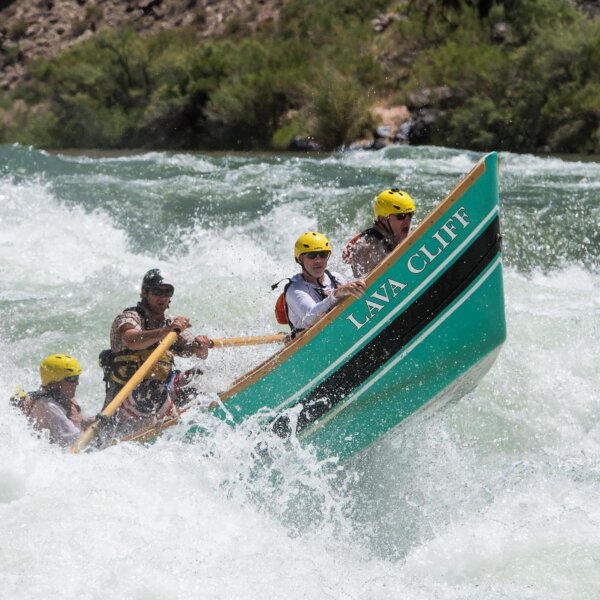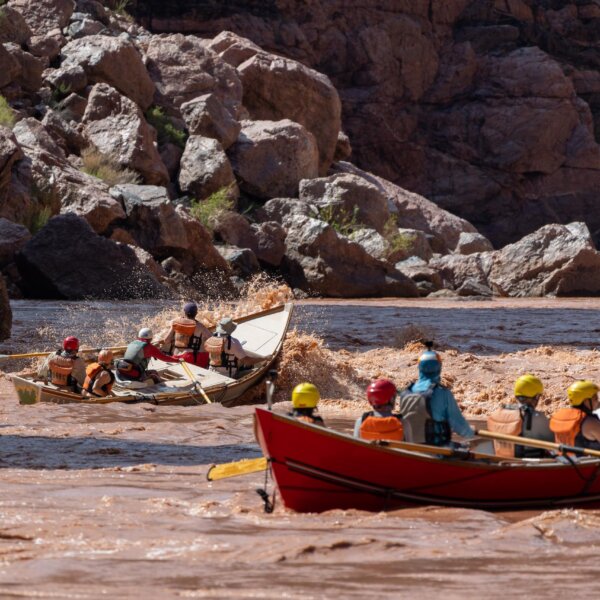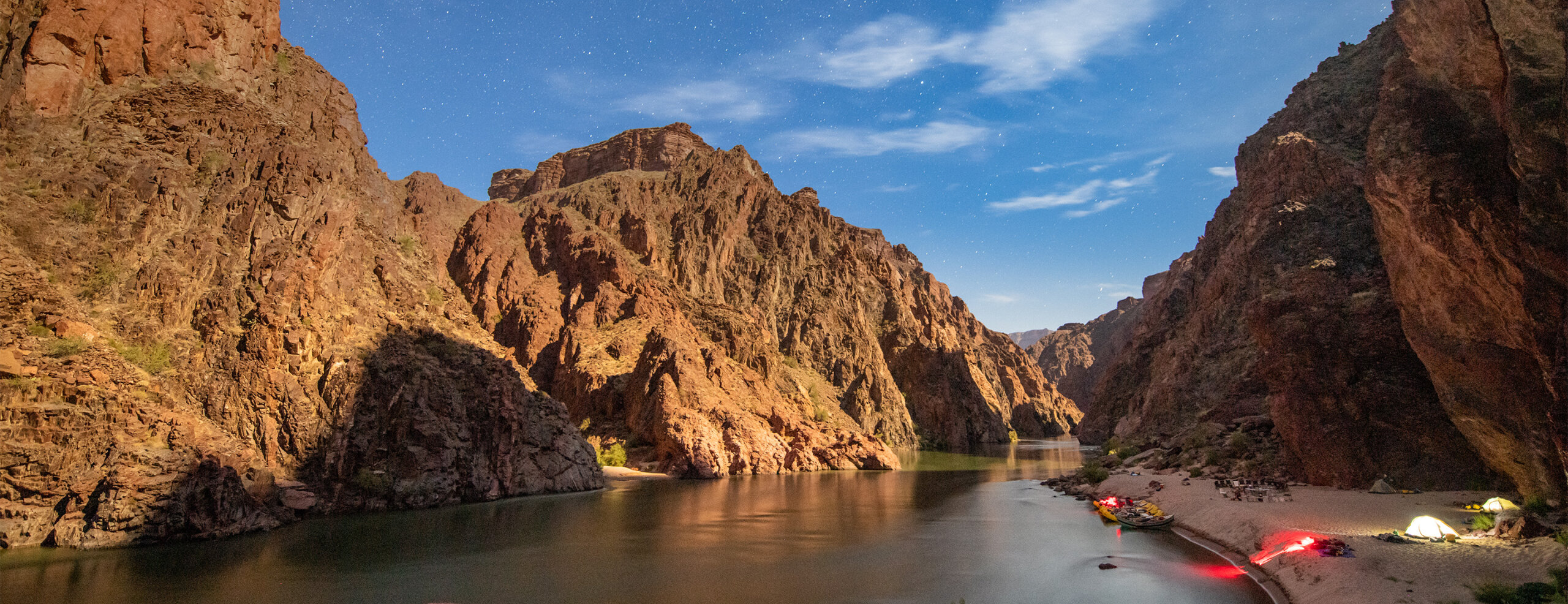
Grand Canyon Rafting Trips
Discover Grand Canyon By Raft: Now Booking 2025 & 2026 Trips
OARS offers more oar-powered Grand Canyon trips than any other outfitter, with raft and dory expeditions ranging from short, 5-day adventures to full canyon journeys 14–18 days in length.
We know there’s a lot to consider before you commit to a trip of this magnitude, and our knowledgeable Adventure Consultants are here to help. Give us a call at 800-346-6277 or fill out our Grand Canyon inquiry form, and we’ll help narrow down your options.
Trips fill up quickly each season. Sign up for our 2027 Grand Canyon priority mailing list to have the best shot at securing a spot on your preferred trip.
Why Choose OARS in Grand Canyon?
Like all of our trips, our guide-to-guest ratio is the best in the business. We limit our Grand Canyon rafting and dory trips to consistently fewer passengers than other outfitters so that you can enjoy an intimate experience with a small group and a slower, more immersive pace that gives our guests the chance to linger in side canyons longer, hike off the beaten path, and experience more of the magic along the way.
And when it comes to guides, OARS employs the most experienced guides on the Colorado River, many of whom have been with the company for decades. Legends in their own time, their enthusiasm, knowledge of the Canyon, and years of professionalism are unmatched in the industry.
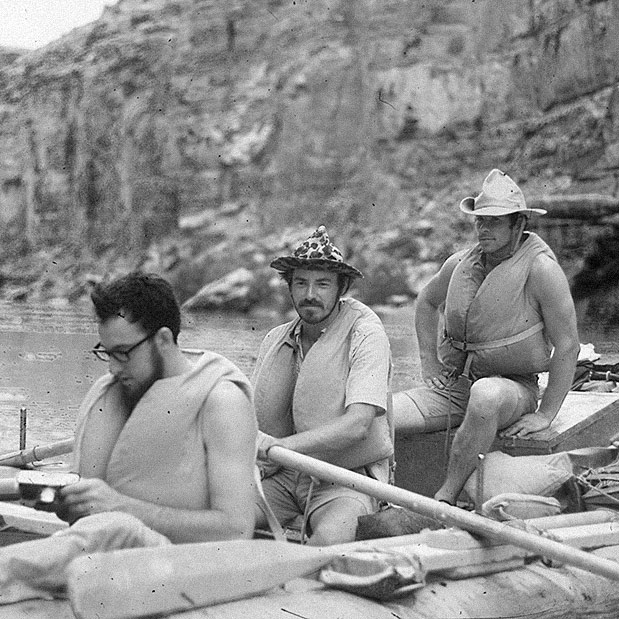
A Legacy of Experience & Professionalism
Since 1969, OARS has been setting the gold standard for Grand Canyon rafting. We were the first exclusively oar-powered outfitter authorized by the National Park Service to run trips on the Colorado River through Grand Canyon, and in 1987 we began to proudly carry forward the Grand Canyon Dories legacy entrusted to us by the company’s founder and renowned conservationist, Martin Litton.
More than five decades later, our family-owned and operated company remains as passionate as ever about sharing cherished rivers and wild places. We’re committed to conservation, responsible travel, and providing unequaled access to more rivers—by raft or dory—than any other outfitter in the world.

Find Your Perfect Trip
Rafting Adventures in Grand Canyon
Grand Canyon Rafting: Whitmore Wash to Pearce Ferry
Location:
Grand Canyon, Arizona
Adventure Level:
Moderate
Minimum Age:
7
Grand Canyon Rafting: Lees Ferry to Pipe Creek
Location:
Grand Canyon, Arizona
Adventure Level:
Challenging
Minimum Age:
12
Grand Canyon Rafting: Lees Ferry to Whitmore Wash
Location:
Grand Canyon, Arizona
Adventure Level:
Challenging
Minimum Age:
12
Grand Canyon Rafting: Lees Ferry to Diamond Creek
Location:
Grand Canyon, Arizona
Adventure Level:
Challenging
Minimum Age:
12
Grand Canyon Rafting: Lees Ferry to Pearce Ferry
Location:
Grand Canyon, Arizona
Adventure Level:
Challenging
Minimum Age:
12
Grand Canyon Rafting: Pipe Creek to Whitmore Wash
Location:
Grand Canyon, Arizona
Adventure Level:
Challenging
Minimum Age:
12
Grand Canyon Rafting: Pipe Creek to Diamond Creek
Location:
Grand Canyon, Arizona
Adventure Level:
Challenging
Minimum Age:
12
Grand Canyon Rafting: Pipe Creek to Pearce Ferry
Location:
Grand Canyon, Arizona
Adventure Level:
Challenging
Minimum Age:
12

Find Your Perfect Trip
DORY Adventures in Grand Canyon
Grand Canyon Dories: Whitmore Wash to Pearce Ferry
Location:
Grand Canyon, Arizona
Adventure Level:
Moderate
Minimum Age:
7
Grand Canyon Dories: Lees Ferry to Pipe Creek
Location:
Grand Canyon, Arizona
Adventure Level:
Challenging
Minimum Age:
12
Grand Canyon Dories: Lees Ferry to Whitmore Wash
Location:
Grand Canyon, Arizona
Adventure Level:
Challenging
Minimum Age:
12
Grand Canyon Dories: Lees Ferry to Diamond Creek
Location:
Arizona
Adventure Level:
Challenging
Minimum Age:
12
Grand Canyon Dories: Lees Ferry to Pearce Ferry
Location:
Grand Canyon, Arizona
Adventure Level:
Challenging
Minimum Age:
12
Grand Canyon Dories: Pipe Creek to Whitmore Wash
Location:
Grand Canyon, Arizona
Adventure Level:
Challenging
Minimum Age:
12
Grand Canyon Dories: Pipe Creek to Diamond Creek
Location:
Grand Canyon, Arizona
Adventure Level:
Challenging
Minimum Age:
12
Grand Canyon Dories: Pipe Creek to Pearce Ferry
Location:
Grand Canyon, Arizona
Adventure Level:
Challenging
Minimum Age:
12

Genuine five star experience. Our family went on a 6-day trip in the GC. The crew went above and beyond to provide an exceptional vacation and rafting experience. Our crew was full of energy, excitement, history, and stories. The raft was top notch, the food was great at every meal, and the entire trip went smoothly – a huge feat given everything it required from the OARS team. Very well done!!! Planning our next one!
Chris Barrand OARS Grand Canyon Guest
MAP OF Grand Canyon
Grand Canyon Rafting FAqs
Have more questions? Contact us.
Which Grand Canyon rafting trip is right for me?
Not all Grand Canyon river trips are the same. Some last five days, others nearly three weeks. Some require hiking in or out of the canyon, some offer helicopter access. There are even different types of boats to choose from.
You’ll find the answers to some of the most commonly asked questions in the FAQs below: route options, types of boats, weather conditions, budget considerations, and more.
You may also want to peruse our guide to planning for a Grand Canyon river trip for a more comprehensive overview of everything you’ll want to consider before booking your trip.
Are motorized or non-motorized Grand Canyon river trips better?
OARS is one of 15 outfitters authorized by the National Park Service to run guided river trips on the Colorado River through the Grand Canyon. Most companies run motorized rafting trips, which utilize larger 35-foot boats that seat up to 15 guests plus a guide and are propelled by an outboard motor. Motor trips cover more ground in less time and are ideal for many travelers, including those who might be looking for a shorter, less active trip at a lower price point.
OARS, on the other hand, specializes in human-powered river trips that include a skilled guide who rows the boat from the center with up to four guests per boat. The boats we run are inflatable 18-foot, self-bailing oar rafts and hard-hulled dories. Both offer a more intimate, organic way to experience the canyon—with fewer guests per trip, a low guest-to-guide ratio, a slower pace and more time to explore the canyon. With OARS, your boat choice generally comes down to whether you prefer an oar raft or a dory.
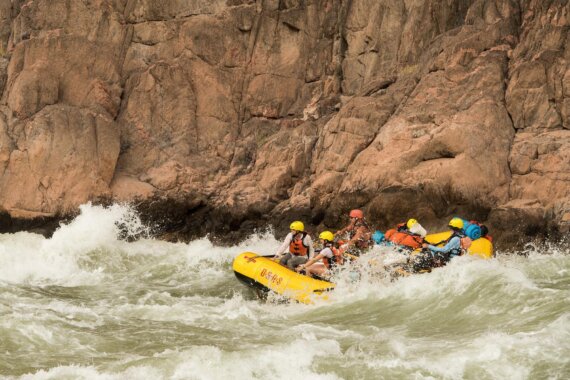
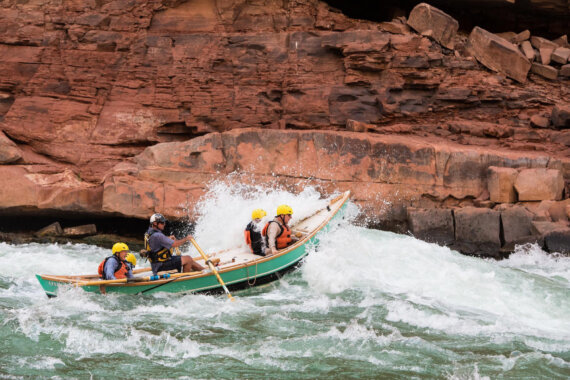
What’s the difference between a raft and dory trip?
On every OARS Grand Canyon river trip, you’ll travel aboard an oar-powered raft or dory with up to four passengers, plus a guide. Both options from the OARS fleet offer an exciting ride through the canyon, but there are some subtle differences to consider.
Oar Rafts
The oar rafts we use are 18-foot, inflatable, self-bailing boats. Soft and forgiving, rafts ride on top of the water and have a certain amount of “give.” In big whitewater, they tend to flex a little and plow through the tops of waves, offering a slightly smoother, more stable experience in big whitewater.
- Participation level: With self-bailing rafts, all the water that splashes in drains out through holes between the inflatable floor and the side tubes, requiring minimal help from guests
- Pros: Guests have more flexibility to move around on the boat, offering a cushier, go-with-the-flow ride.
Dories
Our dory fleet is made up of sleek, rigid boats built from fiberglass, wood and foam. Being a hard-hulled boat, a dory has no “give,” so when a large wave hits, it’s lifted, providing a more pronounced, up-and-down ride through the rapids that gives passengers a rollercoaster-like thrill. Grand Canyon Dories also have a unique heritage of craftsmanship, conservation and adventure that have earned the boats a cult-like following since being introduced to the Canyon by legendary conservationist Martin Litton in the 1960s.
Pros: The unique whitewater experience, coupled with the rich history of dories in the canyon, is part of the allure of these trips. Dory itineraries also typically run a day or two longer, allowing for more hiking and exploration.
Participation level: As a passenger in a dory, you assist in bailing the water out of the boat using a handheld bucket. You also need to be agile enough to quickly shift your weight to the “high side” of the boat when called upon by the guide, to help keep the boat from tipping over.
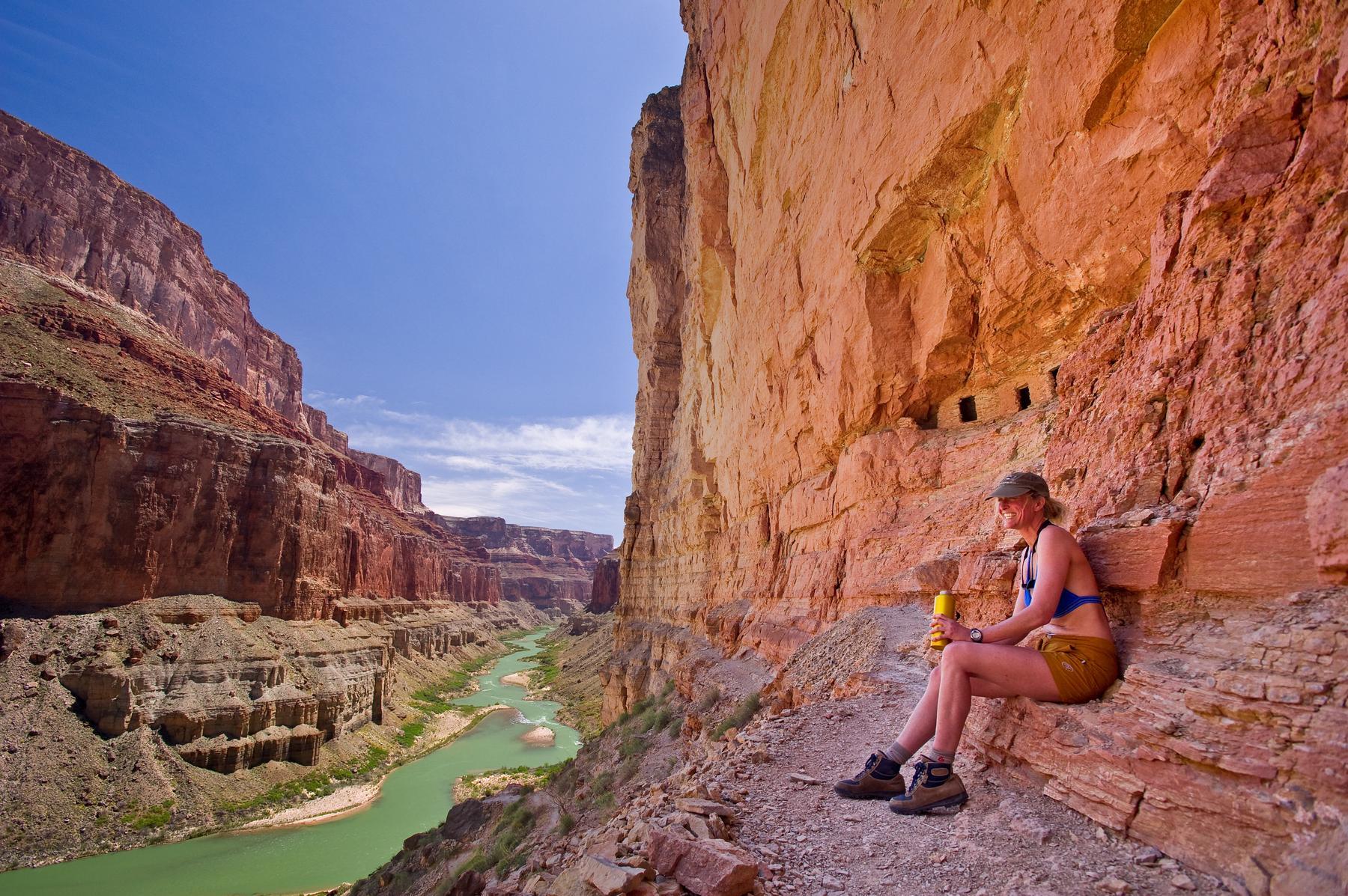
What’s the difference between Full, Upper and Lower Canyon trips?
The Colorado River runs 280 miles through the Grand Canyon, but you don’t have to do it all in one go. OARS Grand Canyon trips begin at either Lees Ferry (River Mile 0), Pipe Creek (River Mile 89) or Whitmore Wash (River Mile 199). The difference between trips all comes down to where you start, how far you go, and what you want to experience.
- Full Canyon Trips: Lees Ferry to Diamond Creek or Pearce Ferry (15–18 days, 225-280 miles): Full Canyon expeditions cover it all—Marble Canyon, the Inner Gorge, Indigenous cultural sites, crystalline creeks, gushing waterfalls, hidden slot canyons, and every major rapid in Grand Canyon. With more time to stop and explore, these 2+ week journeys deliver the most immersive experience. For comparison sake, Diamond Creek trips end just a few rapids short of Pearce Ferry, are typically in fall, and enjoy a shorter return van shuttle back to Flagstaff, AZ.
- Upper Canyon Trips: Lees Ferry to Pipe Creek (6–7 days, 89 miles): Upper Canyon trips showcase Marble Canyon, the playful “Roaring Twenties” rapids, and unique stops like Redwall Cavern, Nankoweap granaries, and the turquoise Little Colorado. The whitewater builds in excitement each day with 19 major rapids before ending with a challenging 7.7-mile hike out of the canyon via the Bright Angel Trail.
- Lower Canyon Trips: Pipe Creek to Whitmore, Diamond Creek, or Pearce Ferry (8–13 days, 99-191 miles): Lower Canyon journeys begin with a 7.7-mile hike into the canyon from the South Rim. From there, you dive straight into the biggest whitewater—Hermit, Granite, Crystal, and Lava Falls—plus iconic side hikes like Deer Creek Falls, Matkatamiba and Havasu Canyon. Depending on the takeout, trips may end with a helicopter ride to the rim and a short flight to Las Vegas, or a van shuttle back to Flagstaff, AZ.
- The Grand Finale: Whitmore Wash to Pearce Ferry (5 days, 93 miles): This short, ranch, heli and river adventure begins with a flight from Las Vegas paired with an overnight stay at a cattle ranch and scenic helicopter ride to the Colorado River to raft the final stretch of the Lower Canyon, including several fun rapids.
In short:
- Full Canyon = the whole Grand Canyon, 2+ weeks of rafting and hiking
- Upper Canyon = shorter trip that eases into bigger whitewater, ends with hike out
- Lower Canyon = hike in, biggest rapids and iconic side hikes
- Grand Finale = perfect introduction to the Canyon for first-timers and families
Are there one-day rafting trips in Grand Canyon?
OARS does not offer Grand Canyon rafting trips shorter than five days, but there are several companies that offer one-day trips in the upper and lower stretches of the canyon, outside of Grand Canyon National Park.
What should I expect when hiking in the Grand Canyon?
For many, the chance to explore remote areas of Grand Canyon National Park and its geological wonders is the biggest appeal of a river trip and there is no shortage of incredible hiking opportunities.
Side Hikes
In general, longer river trips tend to offer more time to explore trails and side canyons. Depending on which trip you choose, you may visit places like Nankoweap, Elves Chasm, Blacktail Canyon, Matkatamiba, Deer Creek Falls, and more.
The easiest hikes are no more difficult than negotiating a few yards of beach sand or stepping over a few rocks. Others may go for several miles or more over a rough trail, climb up a hot hillside, require the use of both hands to ascend over cliff edges or boulders, and demand caution on narrow trails. On OARS trips, all side hikes are optional.
Hiking the Bright Angel Trail
If you sign up for a partial canyon river trip, which begins or ends at Pipe Creek about a mile past Phantom Ranch, you will be required to hike in or out of Grand Canyon on the Bright Angel Trail with 20–30 lbs. of personal gear, plus 8–10 lbs. of food and water. The hike between the South Rim and the river is a serious, long (7.7 miles), and strenuous hike with an elevation increase/decrease of more than 4,500 feet.
Anyone considering a trip beginning or ending at Pipe Creek must engage in focused physical conditioning prior to departure. Hiking out of the canyon is a cardiovascular workout, whereas the hike into the canyon from the South Rim is very punishing on one’s joints, knees, and legs. They are both equally demanding but in different ways. For more information, please review our guide to hiking the Bright Angel Trail.

What is the minimum age for a Grand Canyon rafting trip?
The minimum age for OARS Grand Canyon rafting trips is 12 years old, except for the Whitmore Wash to Pearce Ferry trip, which is 7 years old.
What is the best month to raft the Grand Canyon?
There is no “bad” time to raft the Grand Canyon. The best month to go is really a matter of personal preference. Commercial trips run April through October, each season offering unique conditions that can help you narrow down your preferred trip dates.
- April: Cooler temps ideal for hiking, but potential for storms. Best cactus/wildflower blooming season. Less crowded. Possible campfires at night.
- May: Weather is moderate and consistent, but can be windy at times. Best chance of clear water.
- June: Early June generally has good weather with the possibility for extended periods of 100-degree days. A very busy time to be in the canyon.
- July: Expect any kind of weather. Usually very hot, but can have early monsoons with thunderstorms.
- August: Traditionally hot. Monsoon season with afternoon rain and thunderstorms that often clear up by evening. The clouds and showers can help lower temperatures for a period of time.
- September: Generally moderate temperatures, cooling as the month progresses. There is less traffic in the canyon since September 15 is the last launch date for motorized trips.
- October: Less crowded. Shorter days and cooler weather, ideal for hiking. Possible campfires at night. Yellow blooming plants and ideal oblique lighting for photos.
- November-March: Private trips only. Commercial rafting trips conclude for the season in late October/early November.
For more context, early and late season trips (April, September, and October) are longer, which allows for a more flexible schedule with possible layover days.
Late July through August is historically known as the monsoon season, with occasional thunderstorms. During this time, these localized storms can turn the Colorado River muddy and create spectacular red and brown waterfalls.
What is the weather like in Grand Canyon?
The weather at the bottom of the canyon along the river is typically 20-30 degrees hotter than the temperature at the rim. It’s also important to keep in mind that temperatures and weather can fluctuate greatly throughout the day, regardless of the season.
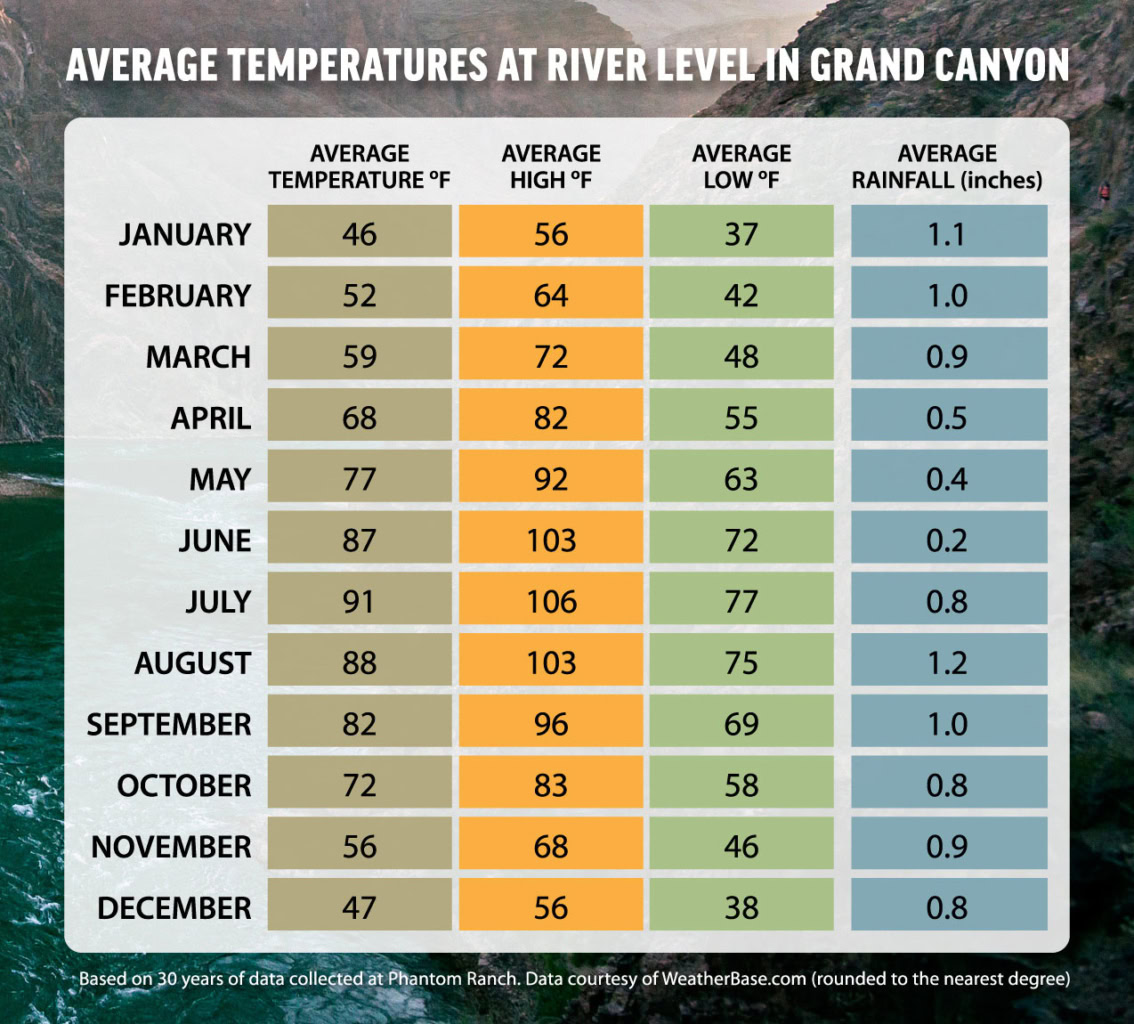
Spring: April temperatures typically remain cool with average lows around 55°F and an average high of 82°F, but rafters should still be prepared for late winter storms. By May, the average temperatures are typically pleasant, ranging from 63-92°F, and weather patterns become more consistent. May is one of the most popular months to raft in Grand Canyon.
Summer: In early June the days are hot and nights are cool, but moving into July, it’s not uncommon for the temperature at river level to rise above 110-degrees. At the same time, temperatures can suddenly plummet and bring rain storms and even late summer monsoons, especially in August. Rafters should be prepared for extreme conditions.
Fall: Fall is a favored season for oar-powered Grand Canyon rafting trips since motorized traffic ends annually on September 15. Daytime temperatures are mild with cooler nights, especially as the months progress. However, the possibility of early season winter storms also increases toward late October. During this window, the hiking conditions are also ideal and exploring the depths of the canyon can be a highlight of the trip.
Winter: Commercial outfitters don’t run during the winter months, November through March. The low angle of the sun means a lot of shade in the canyon and average nighttime temperatures can dip between the mid-30s to 40s. Snow at river level is also a possibility, especially in December and January.
What is the whitewater like on a Grand Canyon rafting trip?
The Colorado River through Grand Canyon has 47 major rapids. The whitewater varies in intensity from mild to wild. Rapids in Grand Canyon are rated in difficulty from 1 to 10—a “1” is flat water and a “10” is the most difficult rapid still considered runnable.
The water levels are regulated by releases from Glen Canyon Dam, and variability in those releases means the height of the river can fluctuate up and down several feet within the day. Because the flow is dam regulated, the water levels remain fairly consistent, even in a drought year, with the higher flows coinciding with summer temperatures and the resulting increase in demand for hydro-electricity. The temperature of the river has historically been 48°- 55° F, though it can trend warmer when upstream reservoir levels are lower.
The great thing about boating in the Grand Canyon is that no matter what the water level, there are going to be fun rapids. Some are better at higher flows, and others better at lower or more moderate flows. Well-known Colorado River rapids like Hance, Hermit, Crystal, and Lava Falls, which offer excitement no matter the water level, are always fan-favorites.
Is the water always brown on Grand Canyon rafting trips?
Not always, but often. The color of the Colorado River in Grand Canyon can change within hours. During monsoon season (typically June–September), rainstorms wash sediment from side canyons like the Paria and Little Colorado into the river, turning it a reddish-brown hue. At other times of year—especially in spring and late fall—you may see striking blue-green water.
What causes the color to change?
The river’s hue is largely shaped by sediment: clay, silt, and oxidized minerals from the surrounding canyon walls and tributaries. Flash floods and runoff can cloud the water quickly, while drier conditions and dam-regulated flows can result in clearer water.
Is it safe to drink?
Yes—once filtered. While the river water isn’t drinkable in its raw form, your guides will filter and treat all drinking water to ensure it’s completely safe throughout the trip. Dishwater is also treated and handled according to backcountry sanitation standards.
Does the muddy water affect rafting?
Not the rapids themselves, but it can reduce visibility of submerged rocks and obstacles. Luckily, our guides are trained to read the river—even when it’s brown and fast-moving.
Can I do more than one Grand Canyon river trip in a year?
Grand Canyon National Park Service regulations prohibit individuals from participating in more than one recreational river trip (commercial or non-commercial) per year on the Lees Ferry to Diamond Creek section of the Colorado River. Because of this regulation, OARS and Grand Canyon Dories cannot accept a reservation from any individual who has or will participate in any other full or partial canyon commercial or non-commercial river trip within the same calendar year. If you have already completed or have plans to participate in any other Grand Canyon river trip during the same year you are traveling with us and would like to go again, please wait until the following year or later for your next trip. Grand Canyon National Park’s one-trip-per-year rule is strictly enforced by the National Park Service.
How much does it cost to raft the Grand Canyon?
OARS Grand Canyon rafting trips range from about $3699 for a 5-day trip to $9,399 for 18-day trips, inclusive of guides, gear, and meals. (Prices vary by trip length)
What can I expect on a multi-day river trip with OARS?
No two river rafting adventures are ever the same, but with OARS, you can count on a high standard of customer service, top-notch equipment, delicious meals, and some of the best guides in the industry providing you with a trip of a lifetime. Find out more about the OARS multi-day river trip experience, including what to expect on the river, camp life, food, and more.
This service is operated by O.A.R.S. Grand Canyon, Inc., a concessioner under contract with the U.S. Government and administered by the National Park Service. The concessioner is responsible for conducting these operations in a satisfactory manner. Prices are approved by the National Park Service.
PLEASE ADDRESS COMMENTS TO:
Superintendent Grand Canyon National Park PO Box 129 Grand Canyon, AZ 86023

Discover your next OARS Rafting Adventure















